#Ancient Israel
Explore tagged Tumblr posts
Text
Native jewish miku 2.0
i really liked the trend so i wanted to try more dress ideas with more embroidery ideas i had. In this one i have a small explanation on the patterns on her dress

Don't mind the different style i am still finding myself i don't have oen consistent artstyle😭
The explanation about the clothes can be seen in my previous miku art and ofc it can't be jewish if there isn't some hebrew.
On the dress i wrote : am israel hai which means "the israel nation lives" (aka jews)
On the background i wrote: shiviti hashem lenegdi tamid which means "I have set G-d before me always"
Here is the background+the patterns on her dress:

Here is a small charts of what is each one:

Side note on "road to canaan": it was a concept a friend of mine had and i gave it life. The swirls represent the israelites walking in the dessert for 40 years and 'getting lost' and the flower is the "star of canaan" or what later became the "flower/star of bethlehem" that was spread worldwide to the world by the crusades and is a big part of the embroidery in a lot of places such as the arab palestinians (mainly), ukranians and more
#jumbler#am israel hai#ישראבלר#jewish#jews#judean embroidery#jewish history#jewish clothing#Jewish culture#Jewish clothes#Native fashion#Nativity#Ancient israel#Ancient judea#miku hatsune#jewish miku#Israeli miku#Judean miku#Israelite miku#hatsune miku#vocaloid miku#artist on tumblr#Israel#Henna#ישראל#יהדות#Culture#Indigenous#Jewish nativity#proud jew
626 notes
·
View notes
Text

1,900-Year-Old Papyrus Records Roman Tax Fraud Trial
The Greek document details a court case in ancient Palestine involving tax fraud and provides insight into trial preparations in the Roman Empire
Back in 2014, a researcher from the Hebrew University of Jerusalem rediscovered an ancient papyrus while organizing a storeroom in the Israel Antiquities Authority’s Dead Sea Scrolls Unit. Once found in the Judean Desert, the document’s script had previously been classified as Nabataean—an ancient Aramaic language—but papyrus expert Hannah Cotton knew better.
“When I saw it marked ‘Nabataean,’ I exclaimed, ‘It’s Greek to me!’” the researcher says in a statement by the university.
Cotton and a team of experts spent the next decade deciphering the 133-line text, and their findings were recently published in the journal Tyche. Turns out, the document is the longest Greek papyrus ever found in the Judean Desert, and its newly translated content is particularly unique: a Roman lawyer’s detailed notes about the trial of two men accused of tax fraud.
“This is the best-documented Roman court case from Judaea, apart from the trial of Jesus,” says study coauthor Avner Ecker, a historian at the Hebrew University of Jerusalem, in the statement.
Per the study, the papyrus was likely written on the “eve of the Bar Kokhba Revolt,” a second-century Jewish uprising against Roman rule. The Roman Empire had colonized Judea—the southern part of ancient Palestine—some 200 years earlier. By 132 C.E., various Roman incursions upon Jewish life, including bans on religious practices, had taken their toll: The dwindling population of Jews in Palestine revolted. The rebellion, led by a man named Bar Kokhba, was crushed by the Romans in 135 C.E., and Jews were subsequently banned from Jerusalem.
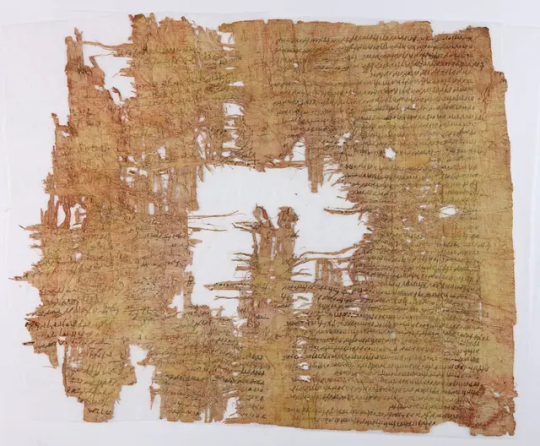
The newly translated papyrus was written after Roman Emperor Hadrian’s visit to Judea around 130 C.E. and before the Bar Kokhba Revolt, per the study. It details Rome’s case against two individuals—Gadalias and Saulos—accused of forging documentation about selling and freeing slaves to bypass paying Roman taxes.
“Forgery and tax fraud carried severe penalties under Roman law, including hard labor or even capital punishment,” says study coauthor Anna Dolganov, a papyrus expert at the Austrian Academy of Sciences, in the statement.
The papyrus was written in “vibrant and direct” language by a strategizing prosecutor, advising another lawyer about pieces of evidence and anticipating objections, per the statement. The document also contains a “rapidly drafted transcript of the judicial hearing itself.”
As Dolganov says in the statement, “This papyrus is extraordinary because it provides direct insight into trial preparations in this part of the Roman Empire.”
Significant portions of the document are missing, making conclusions about the trial’s participants difficult to draw. Still, the researchers write that the prosecutors were likely “functionaries of the Roman fiscal administration” and suggest the defendants were Jews. The papyrus also makes mention of “an informer who denounced the defendants to Roman authorities.”
As Live Science’s Kristina Killgrove writes, the papyrus sheds light on the long-debated question of whether or not ancient Jewish people owned slaves. The document mentions that Saulos’ family owns multiple slaves, but whether those enslaved people were Jewish is unclear.
The trial’s location and the case’s outcome also remain mysterious. Per the study, proceedings may have been interrupted by the Bar Kokhba Revolt. Somehow, this papyrus ended up among a collection of documents stored in caves in the Judean Desert—the Dead Sea Scrolls, which were rediscovered in the mid-20th century.
As study coauthor Fritz Mitthof, a historian at the University of Vienna, says in the statement, the papyrus showcases the Romans’ governmental reach: They regulated private transactions even in remote regions of their empire.
By Sonja Anderson.
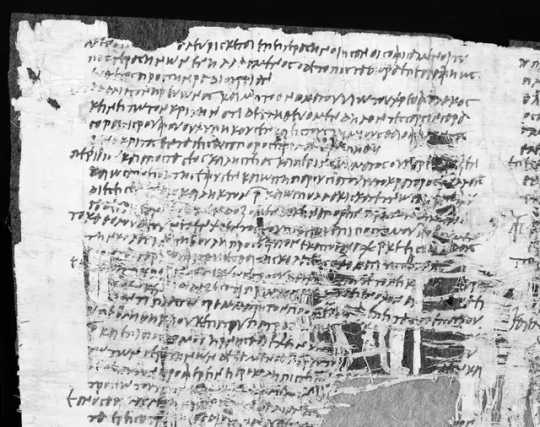
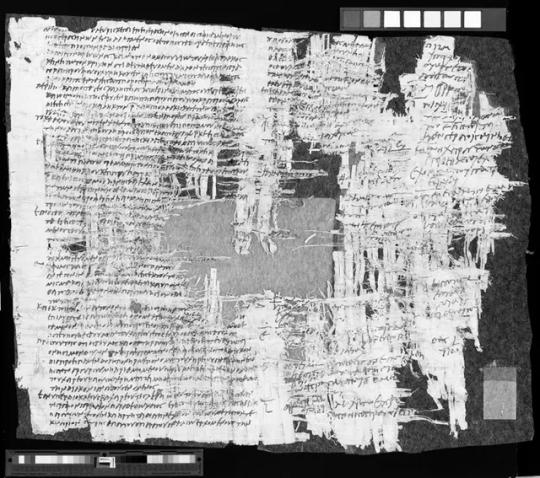
#1900-Year-Old Papyrus Records Roman Tax Fraud Trial#Hebrew University of Jerusalem#greek papyrus#Roman Emperor Hadrian#Bar Kokhba#Dead Sea Scrolls#ancient artifacts#archeology#archeolgst#history#history news#ancient history#ancient culture#ancient civilizations#roman history#roman empire#Ancient Greek#ancient israel
258 notes
·
View notes
Text
Found this podcast on ancient Israel and the use of comparative religion to understand the Tanakh. Sounds great right? Well the host is a militant anti Zionist former Christian who constantly whines about 'israel's colonial ambitions' and 'israeli occupied Meggido', and 'happy Dhimmi'. To make matters even more insulting the guy seems to avoid directly naming Israeli and even Jewish scholars and tends to avoid their work. Even not naming any Israeli archeologists but naming literal British colonists who looted the place. Just another reminder that Jews don't control or own our history. Even during the iron age based on discoveries mostly made by Israeli Jews like Yigal Yadin, Ammon Ben Tor, Abram Faust, etc
#jumblr#anti semitism#Goyim gonna goy#Jewish history#Ancient Israel#antisemitism#Archeology of Israel#He did mention Nissim Amzallag but he's such a weird Chad that he's unavoidable#Can everyone here read Nissim Amzallag?
92 notes
·
View notes
Text
Ancient World Dashboard Simulator

🐢 aristotlestortoise Follow
I'm so sick of these philosophers waving dead chickens around to prove their point like that's not contributing to unnecessary food waste when children are starving in Gaul

🦷 diogenessimp Follow
and who says they didn't eat the chicken afterwards you presumptuous garum sipper
besides how would that benefit a starving child in gaul diogenes did that in athens thats like 6000 stadia away from gaul

🐢 aristotlestortoise Follow
As if donating a day-old chicken that had been used as a prop isn't a hazard for food poisoning or something geez
How about you bring in a live chicken and demonstrate your point with that and then donate it to a godsdamned farmer who can do something with it

🦷 diogenessimp Follow
look neither of us understands diogenes whole school of thought as well as he does and if he thinks using poultry for props is the best choice then imma trust he knows what he's talking about

🦣 giantwoolybones
do you guys know that you are arguing about a dead chicken
24,874 notes

👨👦 corophilus

not to be an art critic on main or anything but has this sculptor ever heard of a dynamic pose
#a boy this age would be moving!!
3 Notes

✊ p-o-p-u-l-a-r-i-s Follow
The people just don't seem to care about how Caligula keeps beginning new construction projects with public funds. People are homeless and starving and he puts up a new theater in the middle of the city as if we need that.
Now he's claiming to be a god?? Plus there's rumors he has sex with his horse.
It's very important that you contact the members of the senate to let them know the people are ready to rise up if they don't depose Caligula. We should get organized and flood the streets.

🎽 crixusstan
I see you not reblogging this. Come on, this should have 200k notes
14,381 Notes

💸 achaemenid Follow
Dude, this invention of the coin is so iconic. Cyrus is gonna go down in history for this one. I mean that in a good way.

🪙 lydianmetallurgy Follow
Sorry but Cyrus stole the entire concept of the coin from us and I'm sick of people acting like we didn't have contributions to make to advancements in science and culture just because we were conquered by your stupid empire. Cyrus is a tyrant and just wants to gather as much power as he can.

🦁 daniyye
Cyrus let my people go back to our homeland, so he's all right by me
#by the rivers of Babylon we sat and wept when we remembered Zion #now we don't have to do that anymore!!
18 Notes

🥇 gladiatorheadtohead Follow
Remember, you're voting for who you think would win the fight, not who you like the best.
24 Notes

🐺 lyca
just left my den and there's just 2 human babies lying on the ground all alone
wtf do i do

🐺 lyca
so i happen to already be lactating so i guess... i just have 2 more cubs now?

🐺 lyca
guys these babies are so cute. i think they're going to do great things one day
#personal #do not reblog i mean it this time 6 Notes

🍆 miletus-leather Follow

The best sex toy shop in Miletus. Come see our selection!

🦌 artemisbow Follow
I'm not one to harsh on a small business trying to make it but I've been to this shop and women are an afterthought here. You'd think the only people interested in dildos were men the way they act here.

🍆 miletus-leather Follow
Women should be weaving and taking care of their children, not coming into our sex shop.

😈 hermescock Follow
K

🐐 blessedsatir
U
64 Notes
#dash simulator#dashboard simulator#ancient rome#classical rome#ancient greece#classical greece#ancient persia#ancient israel#ancient lydia#bonus since i know you want to know gaul was 13000 stadia from athens
514 notes
·
View notes
Text
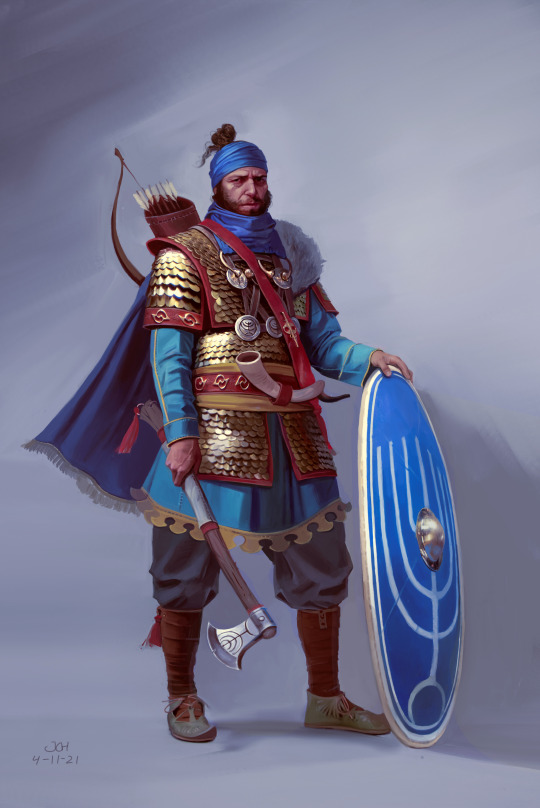
Painting I made a few years ago as a part of my ancient history series. This is an elite warrior from ancient Judea, Second Temple Era. As always I find a great joy in finding the balance between historical accuracy and personal interpretation. Hope you like it!
All the best,
JCH
#dungeons and dragons#board games#concept art#fantasy art#tabletop games#magic the gathering#digital painting#character design#ancient history#armor#jewish#jewish history#judaism#ancient judea#ancient israel#warrior#ancient rome
118 notes
·
View notes
Text
Jewish Life Pre-Diaspora: Jewelry
In my previous post in this series, I looked at something ephemeral and best seen in art; women’s hairstyles [x] and came up a bit short. While I’ll get to men’s hairstyles later I wanted to do something a little easier first, and so am doing a topic archaeology is the best tool at answering: What did indigenous Israelite and Judean people wear as jewelry?
Amir Golani has written the literal book on the subject, and so I’d recommend for further information and techniques you should read his book Jewelry from the Iron Age II Levant or his article Revealed by their jewelry: Ethnic identity of Israelites during the Iron Age in the southern Levant, but I’ll provide a summary and some images here.
Since in his writings on the topic Golani found the Israelites and Judahites (the members of the two Israelite Kingdoms in Canaan in the Iron Age) to be similar in ornamentation trends and groups them together, I’ll be doing the same here under the umbrella term Israelites.
(looooong post beneath the cut. you have been warned.)
Part 1: Distinctly Israelite Jewelry
While trade and the movement of craftspeople led to the dispersion of different styles of jewelry around the Mediterranean, we can see trends that indicate certain pieces of ornamentation are distinctive to Israelite culture.
Three types of pendants, usually made of bone or ivory but sometimes of terracotta or stone, follow the history of the Israelite kingdoms to a surprising degree: originating around the 10th century BCE and disappearing in the 8th Century BCE in the North, and the 7th to 6th centuries BCE in the South (matching the beginnings of the diasporas of Israel and Judah, respectively).
1.1 Club Pendants
These pendants are typically 4-9 cm long shaped pieces with rounded ends and a slightly conical shape. They have been found as far north as the Lebanese Coast and as far south as the northern Negev Desert, though most examples come from the historic borders of the Israelite Kingdoms. Some were plain, but many have bands, latticework, or ring-and-dot ‘eyes’ incised into them.

Similar pendants are found in Ephesus (in Asia Minor) and various sites on the Greek Mainland, but these all date to after the 8th century BCE, are truncated at the top rather than rounded, and only have the horizontal bands as decorations and may have arrived with Phoenician traders (as they had been found in the Phoenician city of Byblos in modern day Lebanon).
1.2 Plaque Pendants
These plaques were made of bone and usually had a stringing hole at one end, or with a tab to be attached to a string. Unlike the club pendants, they have more than a single shape; they can be rectangular or oval, circular or teardrops, and are incised with ring-and-dots, lines, and chevrons.

These have a much smaller range than the club-pendants, with most only being found in the territory of the Judean Kingdom. Two were found at Meggido in Israel’s territory, and one at the site of Hama in Syria.
It was at one point theorized that these served as calendars, since some examples have three rows of ten uniform ring-and-dots, the presence of examples with other, non-calendrical numbers (such as 17) indicates that this could not have been their only use.
1.3 Mallet Pendants
The most restricted of the Israelite pendants, both in morphology and in chronology, these pendants are made of two pieces of bone or ivory; a cylindrical head often decorated with ring-and-dot incisions, and a thin shaft pierced at one end for suspension that was inserted into the head at the other end.

These pendants appear in the 10th Century BCE, but disappear in the 8th Century, despite being found in both Israel and Judah.
The hammer form of these pendants, as well as their strict morphology, has led some to theorize that they were used to identify the wearer, though it is unknown if that identity would be to a profession, religion, or some other faction. Similar looking pendants are found in Sardinia in the 12th-10th centuries BCE, as well as Etruscan Italy and Greece in the 9th – 7th Centuries BCE, but those are made of cast bronze and are a single piece. There, however, we know from context that they were probably linked to the wearer’s profession. Whether this bears true for their Israelite counterparts is still unclear.
Part 2: Inherited Canaanite Traditions
While the bone pendants appear to be an aesthetic choice that evolved along with the Israelite identity, as a part of the Canaanite cultural tradition, Israelites also continued to create and wear adapted forms of Canaanite jewelry. Several styles of metallic jewelry that Canaanites also wore, and do not have aesthetic designs credited to the Phoenicians to the north, may be concluded to be the work of local craftspeople in the Israelite kingdoms.
2.1 Crescent Pendants
These are flat crescent-shaped pendants typically made of copper alloys, silver, or gold, though bone examples have been found. They are either strung through a hollow tab at the center of the pendant, connected to a string via two perforations in the crescent itself, or possibly directly sewn into clothing by those same perforations.

These pendants first appear in the area in the Middle Bronze Age (18th - 16th centuries BCE) and appear in archaeological contexts through the Iron Age II, with designs getting simpler over time.
What they represent is debated. Most intuitive to most people reading this would probably be the crescent moon, which was a widely used symbol in the Ancient Near East, either as a symbol of fertility or of redemption and regeneration. The moon cult has been extant in the region for a long time at this point (Jericho, one of the oldest cities in the world, is named after the local moon god Yarikh, who is also the source of the Hebrew word for The Moon, Yareakh).
Other hypotheses include bulls horns or boars tusks, the later of which were used in the area to ward the evil eye away from horses through the Ottoman Period in the Levant. This is further supported by one of the specimen from the Middle Bronze Age in Megiddo is apparently too large to be worn comfortably by a human, and lines up nicely with a story from the biblical story of Gidon taking crescents as spoils of war from Midianite camels in the book of Judges.
2.2 Rings
2.2.1 Finger Rings
Finger rings with bezels (a wider portion used for mounting or displaying an object or image) are by no means a Israelite invention; the style they imitated comes from Egyptian scarab rings, named for their scarab-shaped bezels, which first appeared around 2000 BCE. However, types were worn by Israelites, and their innovations on the style are of interest.

(Egyptian scarabs and scarab rings, via Wikimedia Commons)
The first style Israelites used, all dating to the 7th and 6th centuries BCE, widens and flattens the metal of the ring at its terminal ends, which can support a scarab or other bezel. The rings are made of silver or gold and flattened ends are decorated with flowers, palmettes, or other forms of decorative flora.
The bezel may be made of gold, silver, faience (ancient glass) or may be absent entirely (though it's possible the bezel was simply lost to the sands of time). Unfortunately, such rings are rare (and some of them are poorly documented), so a more robust typology is difficult.

The second form more closely resembles a traditional Egyptian scarab; a round body to the ring with a flattened area at the tips of the terminal ends to support a bezel that may be swiveled on its axis to show off all sides of the piece (this was very important with scarabs, as the bezel was shaped to resemble like a beetle and the flat bottom bore a seal or inscription). The key difference is the material of the scarabs: where the Egyptian scarab is faience or stone, the Israelite 'scaraboid' is made of metal, and the carved scarab is nonexistent.
These are extremely rare and only appear in the record at the end of the Iron Age II (right before the diaspora) and in the Persian period following, so they may have been a relatively short-lived phenomenon - at the same time similar non-metallic, non-ring seals and scarabs are relatively common.

2.2.2 Large Rings
A form of large ring (that is large enough to fit on a limb rather than a finger) that only appears in Israelite contexts has a catch to secure it in place, using a diamond-shaped end and a U-shaped end with upturned ends. Only four of these have been found, all made of a copper alloy, and all from the latter half of the Iron Age II (8th-7th centuries BCE)

This wearing of metal bracelets and anklets appears to be a holdover from Canaanite traditions, where we see depictions of goddesses wearing such items. That, their rarity, and idea that the innovation here is functional rather than aesthetic, are why I believe is why Golani doesn't consider this as a uniquely 'Israelite' jewelry form.
It should be noted here that these are not the only large rings found in the Israelite kingdoms, and evidence from graves indicate that both men and women wore single, solid metal arm-bands as jewelry. Women may have also worn multiple, simple, large rings as bangles as depicted in figurines (which to my chagrin told me nothing about hair, but I digress). This may be a local innovation by Southern Canaanites and Israelites, as the Phoenicians to the north are not depicted this way. Bangles were made of many materials; copper alloys, silver, gold, iron, and even shell.

(More common styles of large rings found in the Israelite kingdoms alongside the rare locking one above)
2.3 Earrings
The styles of earring Israelites used were innovations on earlier Canaanite styles, and were so numerous I'll just be showing archetypal forms and the uniquely Israelite ones, otherwise I might as well rewrite the whole book.
2.3.1 'Lunate Earrings'
These earrings are solid metal (usually silver or copper, but any nice metal works) with a crescent body, a bent and tapered hoop that is narrower than the body, and ends that usually meet at one side.

(Simple Lunate Earrings, found throughout the Ancient Near East)
The most common Israelite version of this earring, and indicative of the Iron Age II (our time period of interest), widens the lunate and rounds out the whole earring for a more robust, heavy design, often with a small rise in the center of the body

Towards the end of the Iron Age II, the hoop elongates and decorations such as wire wrapping or soldered hoops and globules appear on the lunate, and are made of exclusively expensive metals such as silver and gold.

A unique final example comes from the city of Lachish in the Shephelah of Judah from the 8th century BCE (Iron Age II). 'At least a dozen' lunate earrings were found in a corroded mass in a burial cave. at least one of these depicted the head and torso of a woman, but the corrosion of the pieces precluded further analysis.

2.3.2 Lunates with Fixed Attachments
A more ornamental variation on the lunate where the body has an attachment joined to it. The archetypal form of the attachment is that of a hollow ball, tear, or pear, and is further decorated with wiring or soldered globules. Much more detailed than the basic lunates, these seem to typically be made of nicer metals such as silver and gold.

These evolved from much simpler tear and globule attachments worn by Canaanites as early as the Middle Bronze Age.


There is an variant of these solid globule attachments that is common in the 8th - 7th centuries BCE with a ring of globules supporting a center orb, that I think is neat, but is kind of an evolutionary offshoot of the more ornate attachments.

Towards the end of the Iron Age II, elaborate attachments begin to appear, including clusters, rows, and pyramids (or even rows of pyramids!) of globules, as well as fans and the elaborate hollow examples above.


It should be noted that these more ornate forms of earrings are rare in Israelite society, the simple lunates and solid globule attatchment lunates were by far the most common forms of ear ornamentation.
Part 3: Conclusion
When looking at the more common pieces of jewelry among Israelites, bone pendants and copper alloy metal rings and earrings in relatively simple forms seem to be the most common items, despite the wealth of the kingdoms attested to by Assyrian records of what they looted during their invasions.
Additionally depictions of Israelites generally show them without jewelry (but that may be due to them being depicted by conquerors who took their jewelry, rather than by Israelites themselves).
So what's with this apparent aesthetic of austerity? According to Amir Golani, the Israelite kingdoms may not have been poor, but the Israelite Identity as separate from Canaanites possibly started as a rejection of the Canaanite City State culture of the Late Bronze Age, and a general distaste of luxury goods may have persisted through the development of the ethnicity to a more spartan aesthetic overall (this is not just seen in jewelry, Israelite pottery is basically earlier Canaanite forms, just undecorated, with some exceptions).
If you made it this far, congratulations! I hope this was as interesting to read as it was to look into, and thank you for your time.
#jewish stuff#ancient jewelry#archaeology#ancient israel#israeli archaeology#long post#op is me#JLPD Project
29 notes
·
View notes
Text
Time Travel Question : Medievalish History 8 and Earlier
These Questions are the result of suggestions from the previous iteration.
This category may include suggestions made too late to fall into the correct earlier time grouping. Basically, I'd already moved on to human history, but I'd periodically get a pre-homin suggestion, hence the occasional random item waaay out of it's time period, rather than reopen the category.
In some cases a culture lasted a really long time and I grouped them by whether it was likely the later or earlier grouping made the most sense with the information I had. (Invention ofs tend to fall in an earlier grouping if it's still open. Ones that imply height of or just before something tend to get grouped later, but not always. Sometimes I'll split two different things from the same culture into different polls because they involve separate research goals or the like).
Please add new suggestions below if you have them for future consideration. All cultures and time periods welcome.
#Neolithic#Anatolian#Ancient World#Bible#Isaiah#Prophets#Phoenicians#Proto-Ancient Religion#Pre-Mamluk#Hinduism#History of Religion#History of India#Middle Ages#Religious History#The Pictish Beast#Picts#History of Music#Cathedrals#1000 BCE#Ancient Israel#Slavic People#100 BCE#Petroglyphs#Paleolithic
59 notes
·
View notes
Text
A wonder from ancient Canaan
This Iron Age temple of the emergent Israelite/Judean culture at the site of Tell Arad featured two incense altars and two standing stones. Uncovered ostraca identify it as the "House of Yahweh".










Note: Some of the sanctuary at the Tell Arad site featured in these photos is a reconstruction as portions of the original were taken to the Israel Museum in Jerusalem/al-Quds.
This is a stunning archaeological example of how the Israelite culture right down to something like temple architecture emerged from among Canaan. It was constructed early during Iron Age II by the Kingdom of Judah when the upstart cult of 𒀭Yahweh was just emerging onto the historical record.¹ Some scholars have supposed worship of this Deity emerged from the south and was brought by proto-Israelite settlers to the Judean hill country while another theory posits it was introduced in the Kingdom of Israel to the north as the tutelary Deity of the Omride Dynasty's ancestral clan.² Researchers continue to discuss and debate evidence from ancient texts including the Hebrew Bible and from archaeology to hopefully form a better understanding of the ancient Canaanite and Israelite cultures.
Of course the fact 𒀭Yahweh, most famous as the prototype of the monotheistic, "Abrahamic" (yeah, I don't like that word) concept of God, was worshipped in a polytheistic context and the Israelite culture originated within the Canaanite complex isn't a surprise anymore. How the historical record ties with the ancient texts we call "the Bible" is a fascinating subject on its own, but I also like to think about the stories we can surmise from the remains of the ancient world. I think about if in this ancient community one day, friends who were walking by, some who worship 𒀭Ba'al, some who worship 𒀭Yahweh, some who worship 𒀭Kamosh and yet other Deities, might have noticed groups of priests apparently very upset at one another. None of them, though, are worried about whatever particulars the priests might be squabbling about. They briefly laugh and shake their heads then walk on.
According to the Second Book of Kings in the Hebrew Bible, the House of 𒀭Yahweh at Arad was shut down along with any other places of worship in Judah besides Solomon's Temple in Jerusalem by King Josiah during his religious reforms in the late seventh century BCE.³
References
1. The Editors of the Madain Project. “Tel Arad Temple.” Madain Project. https://madainproject.com/tel_arad_temple.
2. Frevel, Christian. “When and from Where Did YHWH Emerge?: Some Reflections on Early Yahwism in Israel and Judah.” Entangled Religions 12:2 (March 30, 2021). https://doi.org/10.46586/er.12.2021.8776.
3. 2 Kings 23:1–20. New Revised Standard Version, Updated Edition (2021). https://www.biblegateway.com/passage/?search=2%20Kings%2023%3A1-20&version=NRSVUE.
#semitic paganism#semitic pagan#canaan#canaanite#pagan#paganism#ancient near east#iron age#israelite#kingdom of israel#kingdom of judah#yahweh#baal#history#ancient history#canaanites#israelites#ancient religion#religious history#tel arad#tell arad#harad#ancient israel#judea#ancient levant#judah#josiah#polytheism#yhwh#yahwism
13 notes
·
View notes
Note
the fact that you would defend the israeli government after they’ve murdered 30,000 innocents in the largest bombing campaign in modern history is literally despicable and borderline evil. if a genocide documented ad nauseam cannot make you cognizant of israel’s colonial and deeply racist regime, then literally nothing can and you are beyond reasoning with. actually incredible how multiple history degrees have clearly taught you nothing about how a genocide works — or perhaps more concerningly, they have, and you simply don’t care because the victims are palestinian. the fact that you would use those very history degrees to excuse israel’s genocide of palestinians is deeply disturbing and indicative of the rancid hypocrisy within western academia. history will exonerate the indigenous palestinians, and it will be unkind to those like you who defended and cheered on their annihilation.
It‘s so amazing to me that you actually believe this, and that you‘ve so wholeheartedly swallowed the propaganda Hamas (known for using their own civilians as human shields, known for paying their citizens extra for killing Jews) has been peddling. So I am going to paste here some points others have already made that I‘ve saved over the course of information-gathering, though I doubt you‘ll bother to read or learn, judging from your asinine little comments here.
1) Palestine Gaza is a genocidal nation. The goal of the Palestinian government in Gaza is literally to destroy and commit genocide against Israel and kill every Jew by every means possible. This is literally written in their founding charter. "The Day of Judgement will not come about until Moslems fight the Jews (killing the Jews), when the Jew will hide behind stones and trees. The stones and trees will say O Moslems, O Abdulla, there is a Jew behind me, come and kill him. Only the Gharkad tree, (evidently a certain kind of tree) would not do that because it is one of the trees of the Jews." There is no solution for the Palestinian question except through Jihad. Initiatives, proposals and international conferences are all a waste of time and vain endeavors. The Palestinian people know better than to consent to having their future, rights and fate toyed with.
2) Palestine is an apartheid nation that has ethnically cleansed 100% of their Jews and stole their territory after 1948. There used to be tens of thousands of Jews living in the areas of Judea and Samaria, which was renamed to the West Bank by Jordan. However they've all been ethnically after the 1948 Arab-Israeli war and 0 Jews are allowed to live in Palestine today. 3) Palestine is an authoritarian dictatorship both in Gaza and the West Bank. Hamas won majority of the votes during an election in 2006, but the Palestinian president simply refused to recognize the results of the election and refused to hand power over to them. This resulted in Hamas siezing power in Gaza, executing hundreds of their political rivals, and they never held another election. Likewise, the leadership in the West Bank also refused to hold any elections and still continue to illegitimately cling to power. Abbas, the president of Palestine had a 4 year term which was supposed to end in 2009. He's still the leader today and has continued to postpone election after election. 4) Palestine supports the outright open murder of innocent civilians. I've already mentioned the charter of the Palestinian government in Gaza above where their goal is to eradicate Israel and genocide Israelis, but the Palestinian government in West Bank is just as horrible. There's the Palestinian Authority Matry Fund where they literally pay a salary / pension to any Palestinians who commmit terrorist attacks against Israelis, be it through stabbings, shootings or suicide bombings, and they've paid out billions so far. The Foundation for the Care of the Families of Martyrs pays monthly cash stipends to the families of Palestinians killed, injured, or imprisoned while carrying out violence against Israel.
5) Palestine is horribly corrupt oligarchy. Palestine receives billions from the USA and Europe in aid every single year. Whatever money isn't spent on paying literal terrorists, or on rockets to shoot at Israel ends up going to corrupt Palestinian leaders. Yasser Arafat, the first Palestinian leader, died a billionaire. Abbas the current President is worth $100 million. The Palestinian leaders in Gaza, Ismail Haniyeh, Moussa Abu Marzuk and Khaled Mashal have an estimated combined wealth of over $10 billion. Meanwhile the combined GDP of Gaza is only about $2.5 billion, meaning these 3 leaders wealth is equal to 4 years of Gaza's GDP. 6) Palestinians have caused wars and instability in every country that they've sought refuge in. In Jordan, Palestinains assasinated the Jordanian king in 1951, then attempted a coup of a the country in 1970. After they failed, they were expelled to Lebanon where they started a civil war with the Christian Maronites. This war lasted 15 years and killed several times more people than the entire Israel-Palestine war (150k died in Lebanon civil war vs 25k in Palestinian-Israeli wars). In Kuwait, the Palestinians supported Saddam as Iraq invaded Kuwait. In Egypt, they've been hit by several bombings by Palestinians. 7) There is no freedom of speech or equality in Palestine Gaza. No equality of sexes, no equality of races, and definitely no queer rights in the entirety of Palestine where you could be killed for the crime of being openly queer. [If you identify as a liberal, there is literally] no reason to support a country where majority of [your] friends would either have severely restricted rights, be treated like objects, or be thrown off a building just for existing.
Let me reiterate: Jews are indigenous to Israel. Jews have existed and lived in what we now call the Israel-Palestine region for thousands of years before the foundation of Islam, and even before the foundation of Christianity. In the game of “which Abrahamic religion came first?” Islam ranks dead last.
Israel as an identity as a people has existed for thousands of years and has been recorded as far back as the Iron Age on:
i) The Mesha Stele;
ii) The Tel Dan Stele;
iii) The Kurkh Monoliths; and (potentially)
iv) The Merneptah Stele.
While scholars have argued over the translations on the Merneptah Stele, the general consensus among historians, classicists, archaeologist, etc, is that it refers to the existence of Israel at the very least as a collective identity that existed at the time, and was called Israel.
They were eventually repeatedly forced out by other powers such as the Romans and many others, but that doesn’t change the fact that Jews had a continuous existence in Israel before being forced out by what people like you would normally call “colonising powers” were it not so contrary to your own ill-supported arguments. It also doesn’t change the fact that Jews, and Israel, existed before both Christianity and Islam, and long, long before Palestine.
So if your entire argument boils down to "who was here first" and the ideas of "colonialism" and "anti-colonialism" and "decolonisation", then I am telling you, Jews were there first. You could argue Canaanite groups like Moabites and Ammonites were there too, but Moabites and Ammonites don't exist as a continuous group anymore. No matter how you look at it, you are wrong, so let me parrot your horrible argument right back at you:
The fact that you would defend Hamas, a known organisation whose founding Charter literally calls for the annihilation of Jews, who have systematically purged Jews for years, who launched multiple attacks against innocent Jewish people (the music festival, the babies and the woman and the children slaughtered), the fact that there's a Palestinian Authority Matry Fund where they literally pay a salary / pension to any Palestinians who commit terrorist attacks against Israelis, be it through stabbings, shootings or suicide bombings, and they've paid out billions so far; the fact that you defend the existence of the Foundation for the Care of the Families of Martyrs which pays monthly cash stipends to the families of Palestinians killed, injured, or imprisoned while carrying out violence against Israel, etc... that you would defend this is "literally despicable" and not only outright evil, but ignorant to the nth degree.
If the continuous genocidal nature of Hamas against Israel cannot make you cognizant of Hamas' deeply racist, violence, and terrorist regime (to the point where none of the Muslim countries around them will take Palestinians in; even their fellow Muslim countries want nothing to do with them), then I'm not sure what to tell you. You say I am beyond reasoning, but from where I'm standing, your head is so far up your own ass that I don't even know if you're aware of anything that isn't the smell of your own shit.
It's actually incredible to me how you can ignore what multiple historians and scholars are saying because you want to cling to your idea that Hamas are just a bunch of "poor innocent brown people" who need help from the "evil white Israeli regime". Or perhaps, more "concerningly," that is just it: you hate Israel because you erroneously perceive them as white, and so therefore they must be evil. I don't know, but that is what a lot of anti-Israel sentiment seems to boil down to in the world of people like you.
The fact that you would excuse and ignore Hamas' outright horrific acts and ignore history is deeply disturbing and indicative of the rancid hypocrisy within the west, but particularly within western circles that claim to be "progressive", "liberal", and "leftist."
Hamas has said no to every ceasefire. Hamas has said no to every compromise Israel has offered even before October. If Hamas stops fighting, the war ends. If Israel stops, then Israel is annihilated.
History has already shown that Palestinians are not indigenous if we are playing the "who was there first" game with Israel and Palestine, you're just so ignorant that you will refuse to see the evidence right in front of you. You are the one cheering for the annihilation of an indigenous group, and the one history will frown upon is you.
#antisemitism#Sorry for everyone on my dash who had to read this long reply.#I have sat on this for a month wondering whether to release it. Seriously grappling with everything. But.#Here we go. Will I delete it later? I am not sure. But.#There are too few people willing to speak up on this because they're scared of militant Palestinian supporters.#And truthfully I am scared of them! Militant Palestinian supporters are terrifying and my country has MANY#But this is my line in the sand. I so rarely draw them with political conflicts but this is it for me.#If you support Hamas you are DISGUSTING.#And you cannot divorce the fact that the vast majority of Palestinians have supported and do support Hamas.#People literally cheer for Hamas in the streets here and call for the annihilation of Israel.#Universities defend this shit too (see: the scandal with Penn State and Harvard)#I am so open politically I neither identify as right or left I so rarely truly put my foot down and say#'if you believe this you are disgusting'#But? Yeah.#And maybe I will have a mas exodus of followers now but whatever.#ancient Israel
60 notes
·
View notes
Text
Ok so i am late by like a month, i have been busy and STILL didn't finish my native jewish miku but fuck it here's indigenous, native israeli miku with a little of my touch and a small analysis:
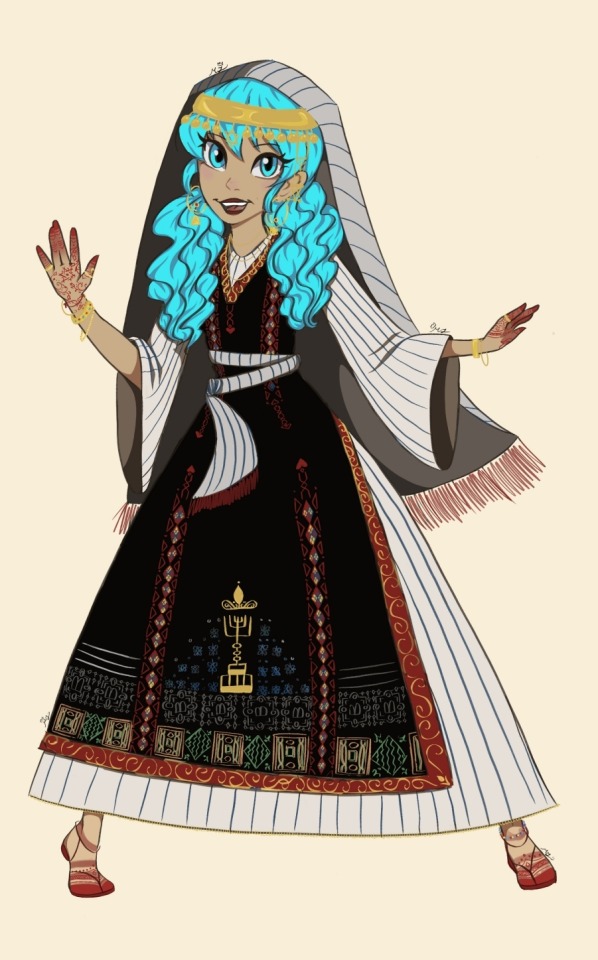
The clothes:
The dress is double layered and based on biblical description i saw of the clothes ancient jews wore i added yellow hoops at the end of the dress to represent the color of our oppression- yellow belts under the muslim rule and yellow stars in the holocaust
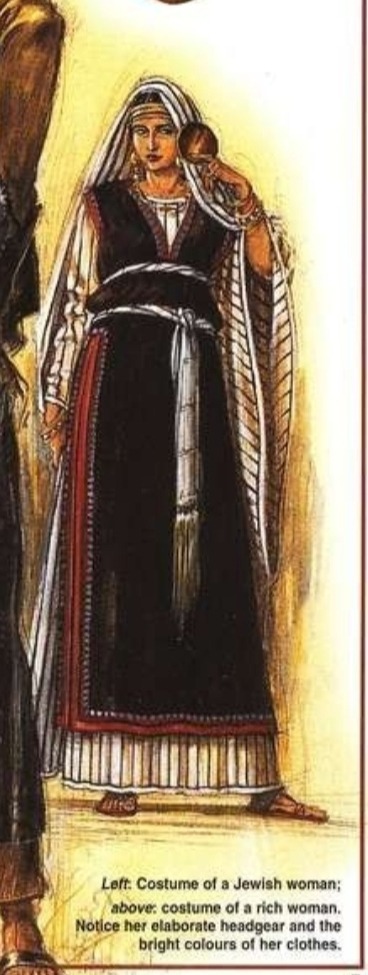
The embroidery:
The Rikma(embroidery) is a personal project i am working on for the past 3 months. The embroidery that WAS practiced on the land eventually was allowed only to muslims and arabs, jews in ottoman syria/palestine were so oppressed and poor they didn't have access to threads and around 1800's some rabbis discoraged jews being involved in arab activity, not only that the jews has completely disconnected themselves from most of the arab culture after the spread of zionism to the land as a form of building their own identity. And if there were jews involved in embroidery it is unknown bc all the photos i see are labeled as "palestinian woman" with no explanation if it is a christian, muslim or jewish.
My project consists of making patterns and motifs based on jewish history, symbols, traditions, land etc and i try to make it original, unique and as diverse from the tatreez as possible to avoid conflict. If any of you want i can explain in a different analysis on what each pattern represents.
The jewelry:
I genuinely suck at drawing gold and jewelry and tried my best to adorn her with as much jewelry as i can. The side piece(that can barely be seen) is also a pattern i came up with, i call it "amulet"
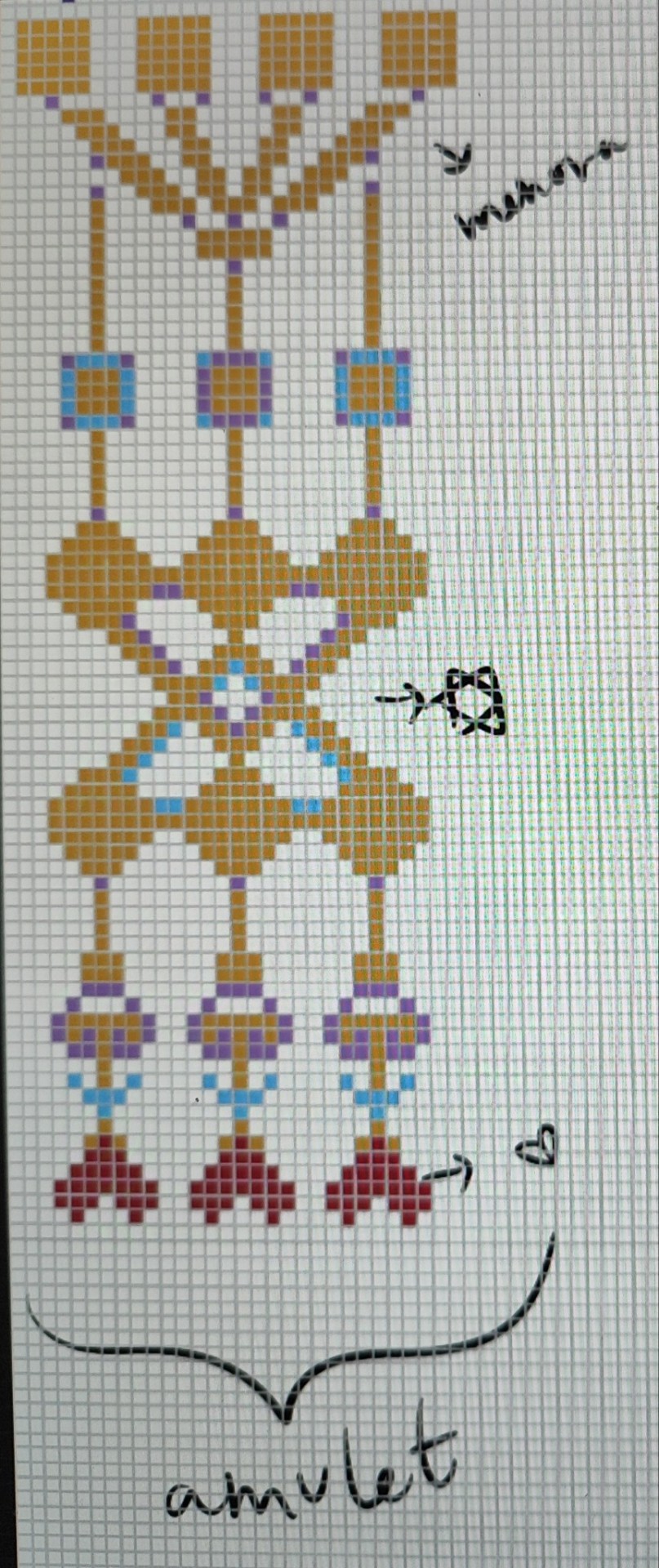
(ps. I forgot to make her a normal necklace, wanted to make it with a hamsa)
Henna:
Henna is still practiced by jews, mainly sefardic and mizrahi jews + ashkenazi jews who grow up and participate in mizrahi culture. The henna on the hands is based on patterns i saw some jewish artists made (on google unfortunately it didn't have names) which has the star of david on it and on the legs i made a mix of bukharan and yemeni jewish henna.
So here it is. A native, indigenous jewish/judean/israeli(te) miku. I tried my best✨
#miku hatsune#hatsune miku#artist on tumblr#israel#Ancient israel#Ancient judea#Judea#Jewish#jumbler#am israel hai#ישראבלר#jews#Jewish history#Jewish culture#Jewish embroidery#Rikma#Jewish symbols#Judaism#עם ישראל חי#מיקו#israeli miku#Jewish miku#Art#Procreate#טמבלר ישראלי#יהדות#jewish traditions#Indigenous#Native
1K notes
·
View notes
Text

Girl Finds 3,500-Year-Old Egyptian Scarab Amulet in Israel
After looking online, the family realized the importance of the object and contacted the Israel Antiquities Authority.
An ancient Egyptian scarab amulet dating back around 3,500 years was found near an archaeological site in Hod Hasharon by 12-year-old Dafna Filshteiner during a family trip, the Israel Antiquities Authority announced on Thursday morning.
While hiking near Tel Qana, Filshteiner was looking for porcupine needles and smooth pebbles when she found an unusual object, which she had initially assumed was a stone.
“I showed it to my mother, and she said it was just an ordinary stone or a bead. But then I saw a decoration and stubbornly insisted it was more than that,” Filshteiner recalled.
After looking online, the family realized the importance of the object and contacted the Israel Antiquities Authority.



The amulet, which features a scarab with two scorpions and other symbols on it, was examined by Dr. Yitzhak Paz, a Bronze Age expert at the Israel Antiquities Authority, who confirmed the scarab was from the Egyptian New Kingdom period, about 3,500 years ago.
Generally, scarabs were viewed as sacred creatures in Egyptian culture and were associated with the early morning sun's Egyptian god Khepri. Since the symbol is connected to the Egyptian pantheon, the scarabs symbolize the concept of existence, growth, and new life.
Additionally, this beetle was seen as a sign of a divine creator because of its ability to create life from a dung ball, as the beetle lays its eggs inside said balls, the Israel Antiquities Authority noted.
Aside from the scarab, the scorpions on the amulet may also hold a religious significance to ancient Egyptians, as "the scorpion symbol represented the Egyptian goddess Serket, who was believed to protect pregnant mothers,” Dr. Paz explained.
The Israel Antiquities Authority also explained that the scarab also has the “nefer” symbol, which means “good” or “chosen,” and a symbol of the royal staff.

#Girl Finds 3500-Year-Old Egyptian Scarab Amulet in Israel#Hod Hasharon#Tel Qana#scarab amulet#ancient artifacts#archeology#archeolgst#history#history news#ancient history#ancient culture#ancient civilizations#ancient israel#ancient art
66 notes
·
View notes
Text
I love the idea of people leaving things in caves for safekeeping and then just never returning or never being able to return.
83 notes
·
View notes
Text
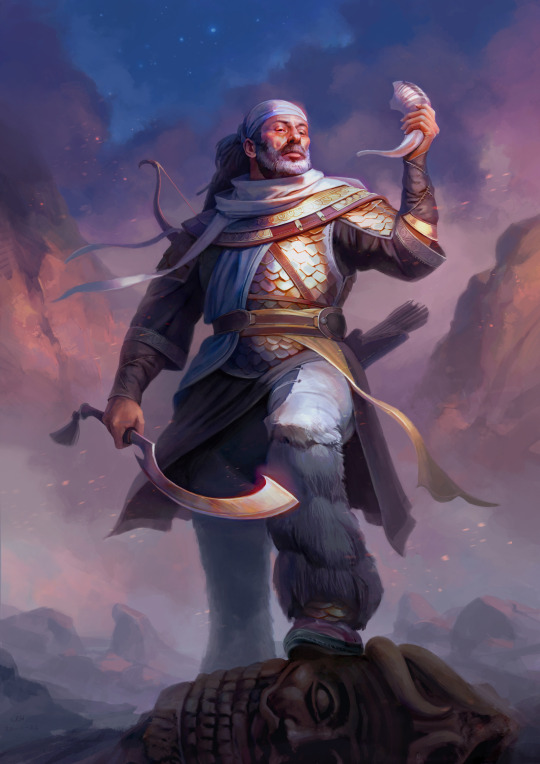
Painting from some years ago I made of a Hebrew Tribal Leader. Artwork was made for my worldbuilding, set in the Bronze Age Levant and explores the different contemporary cultures and mythologies.
I havent posted quite a bit for my worldbuilding, as I decided to explore different subject matters for the foreseable future. (Avatar, Dune, and more to come). Once the time is right and my visual library has grown, I will revisit the worldbuilding and the ancient Levant.
Hope you are doing well,
JCH
#dungeons and dragons#board games#concept art#fantasy art#tabletop games#magic the gathering#digital painting#character design#ancient history#armor#ancient israel#jewish#hebrew#biblical#ancient egypt#ancient assyria
40 notes
·
View notes
Text
Jewish Life Pre-Diaspora: Women's Hair
back in april @mylight-png made a post expressing a desire to learn about small details of "ancient Judean" life such as clothes, jewelry, hair, etc. and I've found the idea of addressing what I, as a Jewish archaeologist, could in that post intriguing. these types of questions are some of the most interesting, but also the most challenging, for archaeology.
Defining "ancient Judeans"
In this, I'm looking for ancient Judeans as defined by Light's quote "I wish to know what traditional, pre-occupation, pre-exile Jewish life was like." which I'm taking as before the babylonian diaspora in 586 BCE, because anything after that date is post-diaspora, and while there were occupations before 586 BCE, I want to be able to give some answers.
Women's Hair
The only definitive visual depiction of Judean women I could find came from the Lachish Relief, a wall decoration in Sennacherib's Southwest Palace in Nineveh, which is in modern-day Iraq. It depicts the outcome of the siege of Lachish in 701 BCE, where the Assyrians sacked the Judean city as a part of Sennacherib's campaigns into Israel and Judah (the same campaign that led to the diaspora of the 'ten lost tribes')
In the relief, women are displayed as wearing long headscarves (below) so unfortunately this tells us little about their hair (in the relief, children are shown as miniaturized adults, so we also learn nothing about girls hair from the relief).
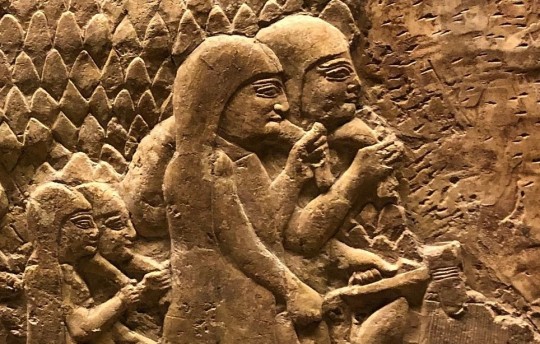
(Image credit: Amanda Borschel-Dan/Times of Israel)
Hope for learning anything about women's hair isn't lost though, thanks to a type of artifact called a Judean Pillar Figurine (or JPF's for short). These figurines are split into two groups: those using well detailed molds, and handmade, more abstract pieces.

(Deutsch, 2022)
Hundreds of JPF's have been found, with over 50% of them coming from the Jerusalem area and all dating to the 9th-6th centuries BCE, which is the time period we're looking for. The primary issue is that we don't know what exactly they were used for, or who they represent. They could be depictions of Judean women, but it's also likely that they are depictions of Ashera, a local fertility deity that was worshiped alongside El/Hashem in domestic settings (religion in pre-diaspora Israel and Judah is messy, I should probably do one of these about it), and it's even been theorized that they are children's toys. The two types may even be used differently, we just don't know. So while I'm going to show the JPF hairstyles, keep in mind that these may not be the actual hairstyles Judean women wore.
The mold-made faces consistently have "voluminous cheek- or chin-length hair framing a face with full cheeks, a mouth that may smile slightly, a chin, nose, and almond-shaped eyes." (Ben-Shlomo and McCormick 2021, 27, image below from the same, 29).
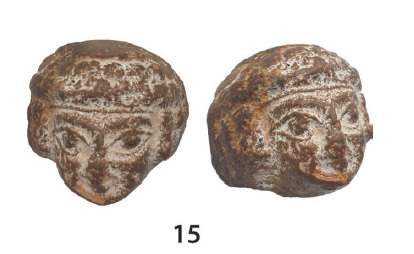
This hairstyle is seen in the area as early as the 12th century BCE, on an ivory flask "bottle figure" from Lachish, which is pre-Israelite, so this hairstyle has been in the region for a while. (Niditch 2008, 44), and may resemble an Egyptian wig in its form, owing to Egypt's cultural influence over Canaanite and early Israelite culture (Deutsch 2022).
This consistency and longevity in the features is also used as an argument that they represent a single individual (again, Ashera), rather than this hairstyle being ubiquitous among Judean women.
Among the handmade, pinched face JPF's, there is naturally more variety, and a possible hairstyle can be seen in them from Tell en-Nasbeh. Some of these handmade JPF's have a headband that has two side locks coming from underneath it (below), and while none displayed side locks without a headband, the reverse isn't true, though exceptionally rare (2 of the 37 JPF's found had a headband without hair).

(Ben-Shlomo and McCormick 2021, 29)
Conclusion
Due to the undetermined nature of the JPFs, and the lack of other evidence at the moment, it's impossible to definitively say "this is how ancient Judean women styled their hair." That being said, I hope I've presented some current ideas from my field that are interesting, and shed a little light on such an ephemeral topic.
TLDR: I couldn't find much, but there is ongoing research into this topic in archaeology.
29 notes
·
View notes
Text
Time Travel Question 18: Ancient History VIII and Earlier
These Questions are the result of suggestions from the previous iteration.
This category may include suggestions made too late to fall into the correct grouping.
Please add new suggestions below if you have them for future consideration.
#Bering Straight Land Bridge#Ancient Israel#Stempunk#Ancient Egypt#Alexandria#Automata#Time Travel#Paleolithic#Neolithic#Domestication#History of Food#Gaul#The Temple of Artemis#Ancient World#Olympia#Halicarnassus#Malaysia
66 notes
·
View notes
Text

As promised @bright-honey
Quick timeline for you.
6000 BCE: First fortified settlement at Ugarit 4000 BCE: Founding of the city of Sidon 4000 BCE - 3000 BCE: Trade contact between Babylos and Egypt 2900 BCE - 2300 BCE: First settlement of Baalbek 2750 BCE: The City of Tyre is founded 1458 BCE: Kadesh and Megiddo lead a Canaanite alliance against the Egyptian invasion by Thutmose III 1274 BCE: Battle of Kadesh between Pharaoh Ramesses II and King Muwatalli II of the Hittites 1250 BCE - 1200 BCE: Hebrew Tribes settle in Canaan 1200 BCE: Sea Peoples invade the Levant (they are important) 1115 BCE - 1076 BCE: Reign of Tiglath-Pileser I of Assyria who conquers Phoenicia and revitalizes the empire 1080 BCE: Rise of the Kingdom of Israel 1000 BCE: Height of Tyre's power 965 BCE - 931 BCE: Solomon is King of Israel 950 BCE: Solomon builds the first Temple of Jerusalem 722 BCE: Israel is conquered by Assyria 351 BCE: Artaxerxes III sacks Sidon 332 BCE: Alexander the Great sacks Baalbek and renames it to Heliopolis 332 BCE: Conquest of the Levant by Alexander the Great who destroys Tyre Jan 332 BCE - Jul 332 BCE: Alexander the Great besieges and conquers Tyre 64 BCE: Tyre becomes a Roman colony 37 BCE - 4 BCE: Reign of Herod the Great over Judea 30 BCE: Egypt becomes a province of the Roman Empire 30 BCE - 476 CE: Egypt remains a province of the Roman Empire 6 BCE - c. 30 CE: Life of Christ 637 CE: Muslim invasion of the Levant. The Byzantines are driven out. 115 CE- 117 CE: Rome occupies Mesopotamia 117 CE - 138 CE: Reign of Roman Emperor Hadrian
We can stop there because that is where the name Palestine comes from. I've omitted a LOT of history here. These are just some main points. Now for some visual aids.


Take these as you will. While archeology evidence has been found to support the Bible, I'm not aware of maps being found but people tend to forget it isn't a document of fiction, real people made it. That being said there is a LOT of evidence of Sea Peoples


The Sea Peoples are very interesting and I highly recommend reading up on them. It has been theorized and is probably true that it wasn't a singular people but different people coming from the sea as different words were used to describe each set that attacked, 8 different versions have been counted so far.
Of the 8, one that has been seen in recorded archeological history was dubbed Peleset or Pulasati. Historians generally identify them with the Philistines - note these are not the same people as Phoenicians according to historians and other experts.

In fact, the first appearance of the term Palestine but in the 5th century BCE and it was by a Greek historian referring to of a district of Syria called Palaistine between Phoenicia and Egypt. This term was used later by other Greek writers and later on by Roman writers. Though, the region was clearly 'Syria' not Palestine. In fact, let's look at a map or two.


So where did Palestine come from? Remember Roman Emperor Hadrian? Yeah, that asshole. Rome had conquered a large chunk of the known world.

The Jews didn't let themselves be conquered sitting down. The Bar Kochba Revolt was actually at the start going well for the Jews but sadly, the Romans took a scorched earth approach to them and it ended with the destruction of the second Temple, as well as renaming the area known as Judea to Palestina to effectively erase all Jewish connections to the land, going so far as naming it after the historical enemies of the Jews.
This is ALL PUBLIC HISTORY.
12 notes
·
View notes